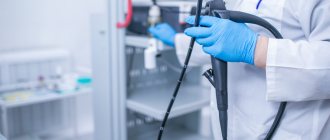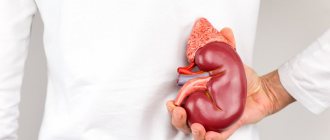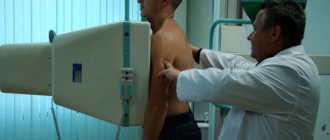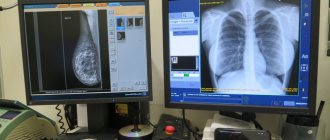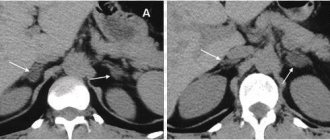November 13, 2021 There are several types of kidney ultrasound: ultrasonography, which detects disorders in organ tissues (inflammation, tumors, cysts, stones), Doppler ultrasound (USDG), which studies the condition of blood vessels to identify injuries, narrowings, blockages) and ultrasound with a contrast agent . The accuracy of the results of each study depends on how well the patient prepares for it. Let's consider the basic rules and nuances of preparing for an ultrasound of the kidneys.
The most important rules for preparing for a kidney ultrasound
Thus, the goal of preparing for an ultrasound of the kidneys in both women and men is to normalize stool to improve the so-called ultrasound window, i.e., to eliminate obstacles to examination. This is facilitated by following a diet, taking a number of medications and a special diet. The patient must follow the following rules describing how to prepare for a kidney ultrasound :
- Within 1-2 days before the test, you need to switch to a diet that eliminates increased gas formation. To do this, foods that cause flatulence are removed from the menu: legumes, cabbage, yeast baked goods, dairy products, brown bread, beer, alcoholic and carbonated drinks, fresh fruits and vegetables. Many experts recommend changing your diet even a week before the procedure. Moreover, you also need to exclude things that cause constipation: strong coffee and tea, sweets, fatty meats, astringent fruits, fast food.
- 1-2 days before the test, take medications that will improve intestinal function: the enzyme drug Mezim, the defoamer Espumisan, as well as sorbents Smectu, Enterosgel or activated carbon. You should check with your doctor about taking them, especially for pregnant women.
- The night before the procedure, have a light dinner. The last meal should be no later than 8-12 hours before the ultrasound. You must come to the procedure with an empty stomach.
- If you have digestive problems (severe constipation, bloating), take a laxative the night before and in the morning or cleanse your intestines with an enema.
In the morning, preparation for an ultrasound examination of the kidneys consists only of cleansing the intestines if the patient suffers from constipation or bloating. On this issue, it is better to immediately consult with the doctor who prescribed the ultrasound. He will advise what medications you can take or how to make a microenema.
Features of preparation: depending on the procedure, for women and men
Preparation for an ultrasound examination of the kidneys depends on the type of procedure. Sometimes the doctor orders an evaluation of not only the kidneys, but also the bladder. In this case, it is necessary not to urinate for 3-4 hours before the test, and 1 hour before the procedure, drink 1 liter of non-carbonated liquid, preferably clean water. If an ultrasound is performed with a contrast agent, then before the procedure you must remove all metal objects and, conversely, empty your bladder.
All of the above rules describe how to prepare for a kidney ultrasound for both men and women. This means that there is no difference in the preparation process. The only difference may be in the diet. Every person knows which foods can cause severe gas. They also need to be abandoned 1-2 days before the procedure.
Abdominal ultrasound - what is it?
Abdominal ultrasound is a non-invasive examination of the patient’s organs and tissues using ultrasound waves. This procedure makes it possible to determine the size and structure of the organ being examined. The principle of operation is quite simple: ultrasound, when it passes through the boundaries of tissues of different densities, changes its characteristics, that is, it is reflected differently. The sensor detects these changes and converts them into a graphic image. This is very similar to how bats or dolphins use ultrasound.
By the way, it was thanks to bats that we learned about ultrasound. It was discovered at the end of the 18th century, but they tried to use it for medical diagnostics only in the 40s in Germany. It is from there that the ultrasound examination method begins its history. The ultrasound machine, also known as a sonograph, has been improved all the time, but the basic design principles remain unchanged. The basis of the device is a sensor, which acts as both a generator of sound waves and a receiver of echo signals. The received data is processed by a computer, then it is displayed on a monitor or printed on paper.
How is an abdominal ultrasound performed?
The patient, stripped to the waist, lies down on the couch. The ultrasound doctor applies a special gel to the surface of the abdomen. A layer of gel is formed between the surface of the skin and the sensor, which ensures good contact and does not allow air to enter; its bubbles can distort the result. Ultrasound gel is made based on water and glycerin. It does not cause allergic reactions, and after the procedure you can simply wipe it with a napkin, there will be no stains on your clothes.
The doctor moves continuously over the surface of the patient's abdomen. Continuity and smoothness of movement is ensured by the gel. The patient may need to lie on his side, inhale and exhale deeply, and hold his breath. This is necessary to focus attention on areas of certain organs. The results obtained are filled out in a protocol, which you take to the attending physician, and he will then draw conclusions. There are no restrictions after an abdominal ultrasound; you can eat, drink and do your usual activities.
How to prepare a child
Preparing children for ultrasound examination of the kidneys is no different from preparing adult patients. There are several nuances:
- Diet changes are contraindicated for infants. The issue of excess gas formation is solved with the help of carminatives.
- For older children, a diet is recommended.
When examining the bladder in parallel with an ultrasound of the kidneys, fluid intake is indicated before diagnosis. The volume depends on the age of the subject:
- A newborn or infant is the usual amount of water that he receives during his next drinking session. Water is given 15 minutes before the procedure.
- Up to 2 years - approximately half a glass of liquid (100 ml).
- From 2 to 8 years - a glass.
- 8-12 l. - two.
- 12-18 - 500 ml or so.
What needs to be done before an ultrasound scan of the kidneys depends on the technique, the need for accompanying examinations (examination of the bladder, prostate gland, etc.). If a standard examination of a paired organ is carried out, even recommendations on refusing food are not always relevant. The basis of preparation is diet, cleansing the intestines of contents and gases. You should check with your doctor for specific measures. The result and the quality of further treatment depend on preparation.
When should you not do an abdominal ultrasound?
This procedure has no medical contraindications; it is suitable for absolutely everyone. However, there are several moments when it is pointless to do an ultrasound, because the results will be inaccurate. This applies to some diagnostic procedures for which a contrast agent is used. It affects the propagation of ultrasonic waves, and this leads to incorrect data. It takes several days for the contrast agent to be removed, after which ultrasound diagnostics can be done.
Abdominal ultrasound is not suitable for obese people. The layer of adipose tissue makes it difficult for ultrasound to propagate. Sound waves cannot penetrate the abdominal cavity far enough. This blurs the resulting picture, so to examine such patients, you need to look for other methods.
Indications
Kidney ultrasound is prescribed by doctors:
- to examine for the presence of vascular damage from impacts;
- when the patient complains of discomfort in the lumbar region or severe pain in the kidney area;
- for preventive diagnosis of people with heart diseases;
- if vascular edema is suspected;
- for diagnosing pregnant women with too late toxicosis at 6-9 months of pregnancy;
- in case of endocrine system failures and problems with the thyroid gland;
- with chronic kidney disease, painful sensations when urinating;
- with high blood pressure and spinal bruises.
Ultrasound of the kidneys and blood vessels is mandatory for monitoring and examining organs after transplantation.
However, you should know that ultrasound cannot replace MRI of the kidneys and blood vessels. It is prescribed as an additional additional examination if ultrasound diagnostics have given alarming results.
Decoding the results
The success of treatment of the urinary system organs, of course, directly depends on the preparation and ultrasound of the kidneys. Only a highly qualified specialist will interpret the results. Self-diagnosis is not acceptable.
In conclusion, the following criteria for the state of the organ will be indicated:
- contours should be smooth and clear;
- quantity – a person normally has two kidneys;
- weight – up to 200 g;
- width – 5–6 cm;
- length – 10–12 cm;
- shape – bean-shaped;
- pelvis – undilated, homogeneous structure;
- location – at the level of 1–2 lumbar vertebrae.
An increase in the size of the kidneys may indicate an inflammatory process in them, blockage of the ureter with a stone, or tumor formation. Whereas organ reduction occurs with hypoplasia.
Using a kidney ultrasound, the doctor will receive information about both the structure of the organ and its functioning. There are no contraindications to an ultrasound examination - it is performed even on newborns, as well as at the stage of gestation. If there is the slightest doubt about the accuracy of the diagnostic results, or the need for additional research, the specialist will recommend other modern methods, for example, computed tomography/magnetic resonance imaging.
Recommendations for adults
Summarizing all of the above, you can create a simple reminder for adults:
- Preparation includes adjusting the diet and cleansing the intestines of gases and natural contents.
- Diet adherence is prescribed three days before the procedure. Prohibited: fresh bread, astringent fruits, legumes, baked goods, baked goods, confectionery, vegetables that cause gas and contain a lot of fiber, fatty meats and fish. You can: lean fish, meat, low-fat dairy products, hard cheeses.
- You can cook food by boiling or steaming.
- You need to eat in small portions so as not to overload the digestive tract and not slow down the food processing process.
- Cleansing the intestines from gases is possible with the help of sorbents and special carminative drugs. The doctor will give specific recommendations with the names of the products.
- Cleansing the intestines of contents is carried out using laxatives, enemas and microenemas. At the discretion of a specialist, taking into account the state of health. Unauthorized use of medications is prohibited; side effects and complications are possible.
You need to come to the clinic 10-20 minutes before the procedure. During diagnosis, the doctor gives instructions that will allow better visualization of the tissues of the paired organ. They need to be fulfilled. Upon completion, the patient receives an examination protocol and a conclusion from a diagnostician. With the result, you need to contact your treating specialist: a nephrologist or urologist.
Is it possible to drink before an abdominal ultrasound?
Naturally, you cannot drink alcohol. During the period of preparation for an ultrasound of the abdominal cavity, you must cleanse the body as much as possible; alcohol clearly does not contribute to this. Alcohol, like nicotine, causes an altered state of internal organs. For example, alcohol enlarges the liver and constricts the blood vessels of the stomach walls, and we get an inaccurate result. Alcoholic drinks may cause gas. Some wines, in particular champagne, cider, and low-alcohol drinks are saturated with carbon dioxide bubbles, which then accumulate in the stomach. They affect the accuracy of the study.
And lastly, patients come for an abdominal ultrasound only as prescribed by a doctor or with certain symptoms. Most likely they are sick. So think about it: maybe you should give up alcohol altogether? Or should I wait, at least until I fully recover?
How long before the procedure should I completely stop taking fluids?
According to the examination preparation protocol, the patient should take a maximum of 0.5 liters of H2O, unsweetened tea 1 hour before the examination . After this, he is not recommended to empty his bladder. At the start of the ultrasound, the patient should feel a slight urge to urinate.
Therefore, after drinking the volume of water specified in the protocol for preparing for the examination, it is prohibited to drink any additional drink. Violation of this rule may distort the real picture of the state of the urinary system.
Read about how to properly drink water before an ultrasound in this section, and about the proper use of water by a person - in this section.



